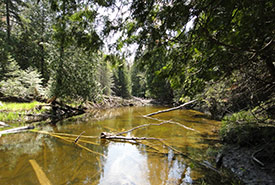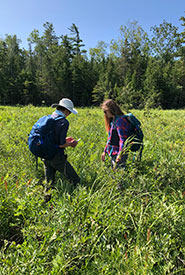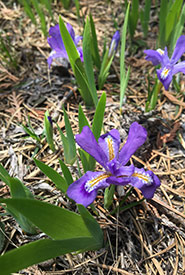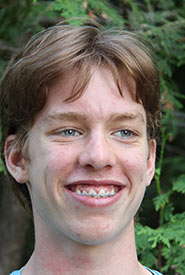Having a field day

Crane River Tract, ON (Photo by NCC)
This summer, I spent a few days volunteering with the Nature Conservancy of Canada (NCC). My family owns a cottage on the Bruce Peninsula, so we are close to several NCC properties. My dad already knew Esme Batten, NCC’s coordinator of conservation biology for the Saugeen Bruce Peninsula, and I had heard lots of good things about her. I was really excited to meet her! My favourite subject in school is biology, and I’m very passionate about helping the environment.
On the first day of volunteering, my mom and I drove to the NCC office in Ferndale. There we met Esme and her two summer interns (Naomi and Erik). We started at an NCC property just south of Tobermory. Every time we stopped at a new property, Esme had us spray our boots with a bleach solution to prevent the spread of invasive species.
Our first job on the property was to complete some trail monitoring and look for rare and invasive species. On the walk, Esme taught us about lots of different plants and how to identify them.
The next day, we split into two field teams: Esme, my mom and me, and Erik and Naomi. We headed over to NCC’s Crane River Tract to check on a population of invasive phragmites that Esme managed last year. We had to bushwhack for quite a bit to reach the wetland.
Esme and the rest of the NCC field staff use a GPS mapping app called Collector to navigate the properties. Using the app, you can add waypoints and points of interest to help describe the property and show the best routes to bushwhack while mapping significant species, invasive species, etc. On the way to the next property, Esme taught us more native plant identification. The phragmites management work from last year worked very well, as there were only a few stalks left. We stood in thigh-deep water to cut these stalks underwater and close to the ground to drown them. We had lunch with the mosquitos on a dry spot in the wetland. The bushwhack back was somewhat less comfortable because our boots were flooded with water!

Jasper and Esme on a field day. (Photo by NCC)
On the third day, my dad came with me. We headed over to a property in Johnson’s Harbour to do some more phragmites monitoring. Esme and her technicians had discovered a new patch of phragmites in a wetland there, but they weren’t sure if it was native or invasive. We were going to bushwhack to the wetland to take samples of the plant for DNA testing. On the way there, we stopped at a different wetland to cut down the few remaining stalks of phragmites that had been managed for the past few years. While we were there Esme taught us how to do “pshing.” It involves making sounds with your mouth at the same frequency as common songbird alarm calls. The birds become interested and come flit around near you. This can be a useful technique for conservationists to check the identification of a bird that is only heard or seen fleetingly, but it is especially important not to do this during the breeding season, so as not to disturb them.
We continued to the next wetland. Upon closer inspection, Esme believed that the phragmites are invasive because they are very tall and the ligule (where the leaf meets the stalk of the plant) is quite large. We still took DNA samples for testing and mapped the area.

Dwarf lake iris (Photo by NCC)
On the way back, Esme took us to an area of the property that most people don’t know about. There were thousands of, if not more, orchids. Orchids are very sensitive, and if you step on them or if there is too much disturbance near them, they will die. The orchids were beautiful, and it was one of the most amazing things I have ever seen.
On the way back home, she took us through a massive patch of dwarf lake iris, which is globally rare, but that’s hard to believe considering how many are growing here. On the drive back to Ferndale, we made a pitstop at an alvar — a globally rare ecosystem. A significant number of the world’s alvars are found in Ontario. She taught us the plants that can be used to identify an alvar.
I really enjoyed volunteering with Esme and NCC. I learned a lot about botany and conservation. I would definitely like to volunteer again next summer. I plan to study a conservation-related program in university. Maybe when I’m old enough, I’ll get to do an internship with Esme and get a job like hers.


